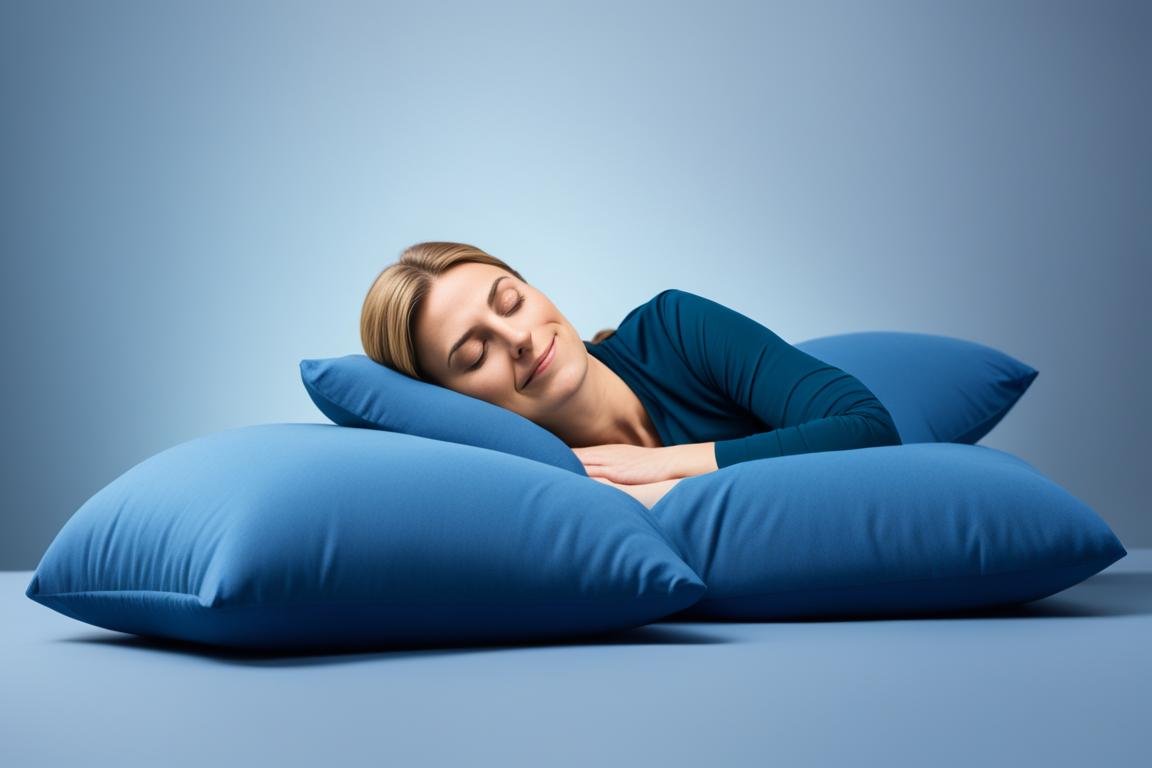Sleeping right is important for your upper back pain. Knowing how to align your spine and neck can make a big difference. Learn some good sleeping positions. Also, find out about the best accessories that could help you sleep better.
Key Takeaways
- Proper spinal alignment and pressure distribution are key to relieving upper back pain during sleep.
- Sleeping on your back or side can help open the space between spinal vertebrae and reduce tension on discs.
- Utilizing pillows and adjusting your sleep environment can significantly impact your sleep quality and pain management.
- Avoiding stomach sleeping and finding the right mattress and pillows can contribute to better spine alignment and reduced upper back discomfort.
- Seeking medical attention is advisable if upper back pain persists or worsens despite lifestyle modifications.
Understanding Upper Back Pain
Many things can cause upper back pain. These include bad posture and muscle strain. Other causes are herniated discs and some health conditions. The upper back pain causes can be simple, like sitting wrong at your desk. Or, they can be more severe, like problems with your spine or discs.
Causes of Upper Back Pain
Poor posture is a big reason for upper back pain. When you sit or stand slouched over, it harms your back. This puts a lot of stress on your muscles and bones. It makes your upper back feel sore and painful.
Symptoms of Upper Back Pain
You may feel your upper back aches. It might be hard to move your neck and shoulders. You might feel tightness or stiffness there, too. Sometimes, you feel the pain in your neck, shoulders, or arms.
Impact on Sleep Quality
Upper back pain can make sleeping hard. Finding a good position to sleep in can be tough. This leads to nights where you can’t get good sleep. And not sleeping well can make your pain worse. It’s a cycle that can hurt your body and mind.
The Importance of Proper Sleep Posture
Sleeping in the right way is key to help your upper back feel better. It’s all about keeping your spine and neck in good shape. If they are not aligned well, it can cause a lot of pain. So, finding a good sleeping position is very important. This can make you more comfy and help you sleep better.
Alignment of the Spine and Neck
It’s important to keep your ears, shoulders, and hips in line when you sleep. Doing this even helps your spine stay healthy. For example, putting a small pillow under your knees when sleeping on your back is a great idea. It helps your spine relax.
Pressure Distribution and Relief
How your body’s weight is spread during sleep matters too. If your weight is not spread well, your back may hurt. To fix this, you can use special pillows and accessories. They help spread your weight just right. For people who sleep on their side, a firm pillow between their knees works wonders. It stops their spine from twisting and eases pressure on their hips and lower back.
Best Sleeping Positions for Upper Back Pain
Sleeping on your back can help with upper back pain. It spreads weight evenly on your spine. This stops too much pressure on your upper back. Also, putting a pillow under your knees helps to keep your spine in a nice curve.
Sleeping on Your Back
Sleeping on your side is good for back pain too, especially with a pillow between your knees. This keeps your spine straight and lessens upper back pressure. Remember to switch sides to stay balanced.
Sleeping on Your Side
Try sleeping in the fetal position. It’s on your side with knees close to your chest. Good for those with upper back pain, like from a slipped disc. This pose opens the space between your spine bones. It lowers tension and gives some relief.
Fetal Position
sleeping position for upper back pain
Using Pillows for Support
Placing pillows just right can help with upper back pain when sleeping. They fill in spaces between you and the bed. This keeps your spine in a good line and spreads weight better. The right amount of pillows can really make you feel better.
Avoiding Stomach Sleeping
Sleeping on your stomach isn’t great for upper back pain. It adds more pressure to your spine and neck. This can twist your neck, making pain worse. But, if you must sleep this way, try using a very thin pillow. Placing another under your pelvis can ease the strain on your back.
Ergonomic Sleep Accessories
The mattress you pick can really help with upper back pain. A high-quality, supportive mattress molds to your spine’s natural curves. This reduces pressure on your upper back. It’s good to choose a mattress that keeps your spine in line while you sleep.
Cervical pillows are great for keeping your neck and spine in the right position. For people with upper back pain, these specialized pillows are key. They cut down on upper back strain by supporting your neck and keeping your spine straight through the night.
Plus, there are other supportive cushions that can help ease upper back pain while you sleep. Lumbar support cushions, shoulder pillows, and wedge-shaped cushions are available. You can place them in spots to get relief and to keep your spine aligned well.
| Ergonomic Sleep Accessory | Benefits for Upper Back Pain |
|---|---|
| Best Mattress for Upper Back Pain | Provides adequate support and conforms to the natural curves of the spine, helping to alleviate pressure on the upper back. |
| Cervical Pillows for Upper Back Pain | Supports the neck and maintains proper spinal alignment, reducing strain on the upper back. |
| Supportive Cushions for Upper Back Pain | Includes lumbar support cushions, shoulder pillows, and wedge-shaped cushions that can provide targeted relief and promote proper spinal alignment. |
Adding these specialized sleep accessories to your bed can lessen upper back pain. It also helps you sleep better and more deeply.
Sleep Hygiene and Back Health
Good sleep rules are key for dealing with upper back pain. Making the spot where you sleep quiet and comfy matters a lot. This means having a room that’s not too warm or cold, with soft light, and little noise. It helps your body fix from upper back pain. Have a set bedtime routine. And don’t use screens before turning in. This makes your sleep better and helps your upper back feel less sore.
Creating a Restful Environment
Your sleep space is vital for resting and healing your upper back. Make sure it’s not too hot or cold, not too bright, and quiet. This helps you sleep well and aids in getting better from pain. A peaceful room calms your mind for deep, healing sleep.
Bedtime Routine
A regular bedtime routine can really help with upper back pain. This could be light stretching and using ice or heat. Also, calming your mind with deep breaths or meditation helps. This gets your body and mind ready for sleep. It makes you sleep better and heal faster.
Focusing on where you sleep and how you get ready for bed can boost your sleep. It also helps you deal with upper back pain. This all-around sleep-care way leads to better and deeper sleep. It’s great for your back and overall health.
Upper Back Pain Relief Techniques
Stretches and exercises can really help with upper back pain. By strengthening and making your upper back muscles more flexible, you can reduce pain. Always check with a healthcare professional for the best exercise plan for you.
Stretching and Exercise
Physical therapy is great for upper back pain. A therapist will show you exercises and stretches that help. These stretches and exercises offer both quick and lasting relief, and they keep problems away.
Heat and Cold Therapy
Heat and cold therapy work well for upper back pain too. Heat boosts blood flow and eases muscles, and cold cuts down swelling and pain. Using both ways, or just one, can help a lot. At home, try heating pads, ice packs, or warm baths for relief.
When to Seek Medical Attention
If your upper back hurts a lot, even after trying home treatments, see a doctor. Persistent or worsening upper back pain might mean a serious problem that needs checking by a professional.
Persistent or Severe Pain
Does your upper back keep hurting or get worse? You really need to see a healthcare professional. It could be a bigger issue needing medical help, like a bad injury or an unknown condition.
Neurological Symptoms
Feeling numb, tingling, or weak in your arms with upper back pain is serious. These signs could point to nerve problems. A healthcare pro should check you to see what’s up.
If your upper back hurts a lot or keeps being a problem, seeing a doctor is a must. They can find out what’s really going on, and help you feel better. It’s about making sure you’re well.
Sleep Posture Modifications
Figuring out the right way to sleep to help with upper back pain can be a journey. It’s all about finding the best setup for you, which might take some time. You want to slowly change how you sleep to avoid any new aches and pains. This way, you can make sure your body is okay with the switch.
Gradual Adjustment
Changing your sleep position for upper back pain should happen bit by bit. Start by using extra pillows or moving them around. Then, continue adjusting until you find what works best for you. Letting your body get used to these changes slowly can make them stick without causing extra pain.
Monitoring Progress
It’s important to keep an eye on how your new sleep position is working. Notice how you feel, how well you sleep, and if the pain gets better. This way, you can tell what helps and what doesn’t. It makes finding the perfect sleep position for your back pain easier.
Therapeutic Sleeping Surfaces
For folks with upper back pain, the right sleep setup is key. It can ease pain and make sleep better. Adjustable beds and special mattresses are top picks for this.
Adjustable Beds
Don’t count out adjustable beds if your upper back hurts. These beds let you adjust your head, torso, and leg positions. You can find just the right spot to sleep and reduce upper back pain.
Specialized Mattresses
Aside from beds, specialized mattresses for upper back pain can help too. They’re made to relieve pressure and support your spine. A great ergonomic mattress can really up your sleep game and cut back on back pain.
Conclusion
Getting rid of upper back pain while sleeping right is very important. This help you have a good night’s sleep without pain. It’s all about keeping your spine in line, picking the best pillows, and using the right sleep gear. Changing how you sleep might be hard at first. But, a morning with no pain thanks to a good night’s rest is worth it.
Research in this article talks about how common and costly upper back pain can be. It also shows that certain ways of sleeping can help a lot. By picking the right sleeping positions, finding good pillows and beds, and having healthy sleep routines, you can feel better. Remember, sleep is when your body heals the most. So, taking care of how you sleep is very important for your health.
Switching how you sleep might seem big, but the outcome is huge. Enjoy the process of finding what’s best for you to sleep well. If you keep trying and don’t give up, you can sleep through the night without back pain.




